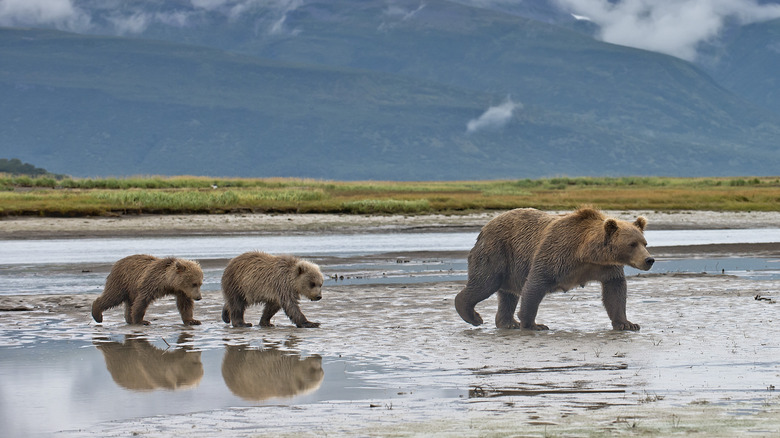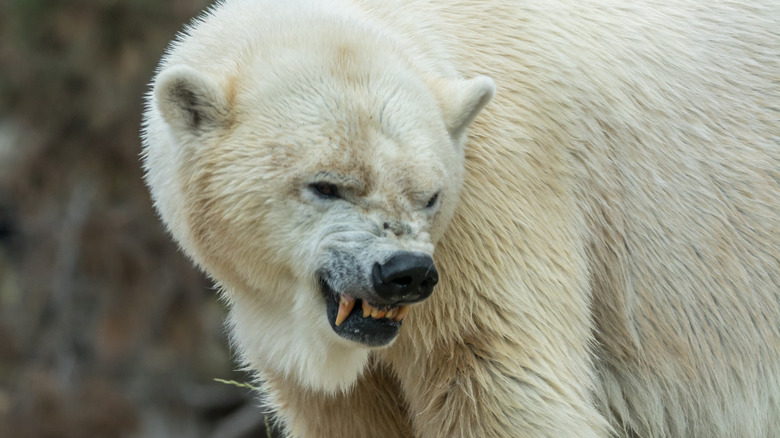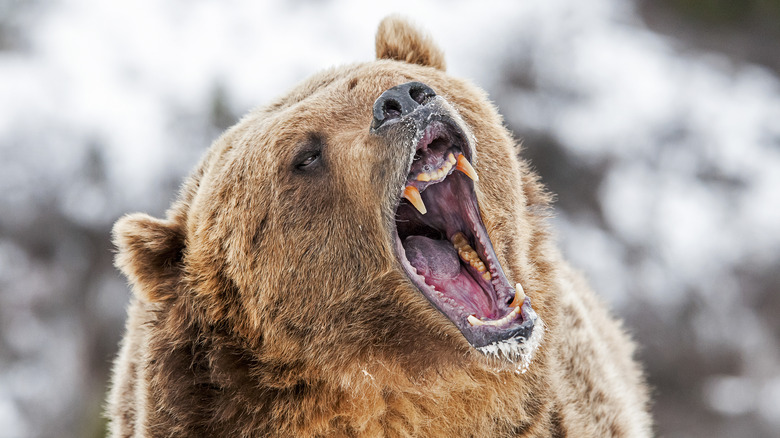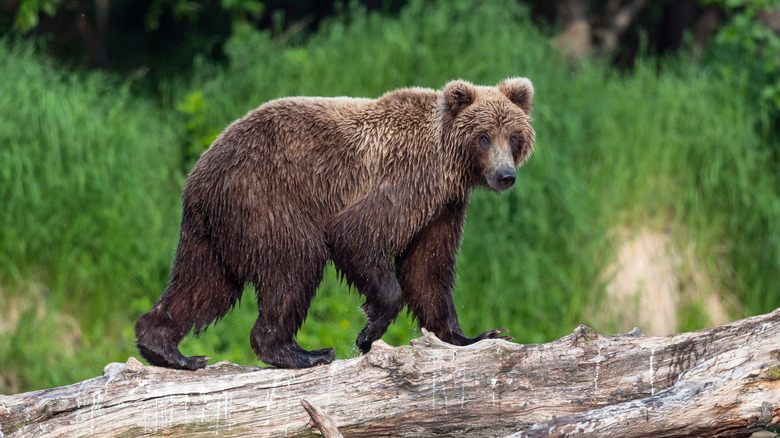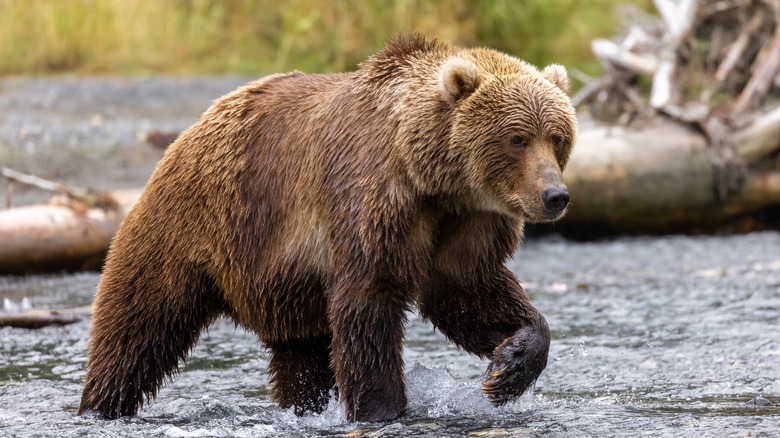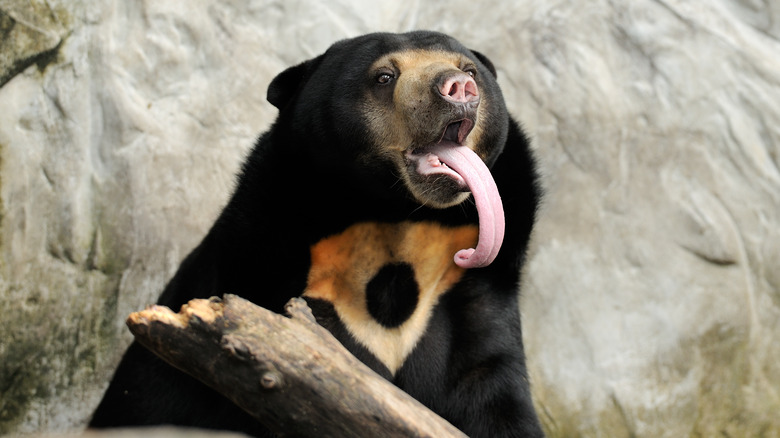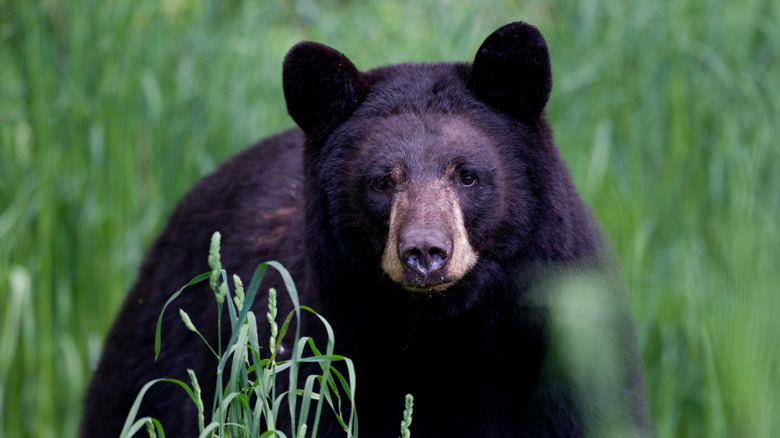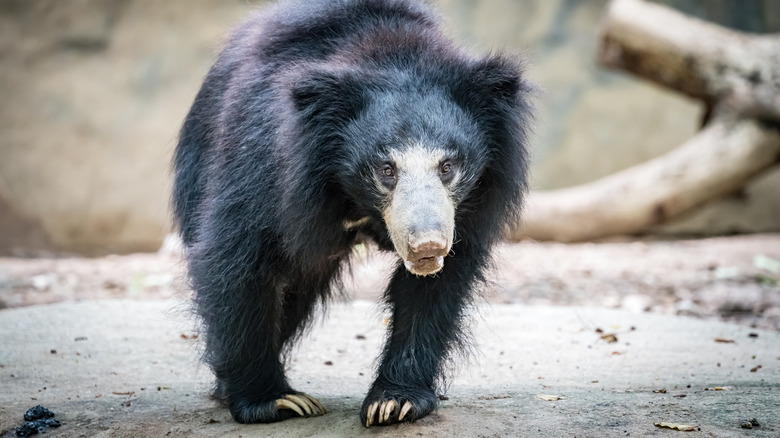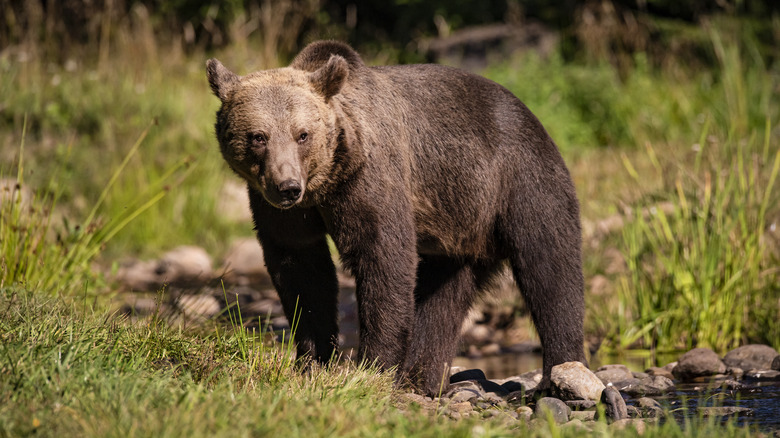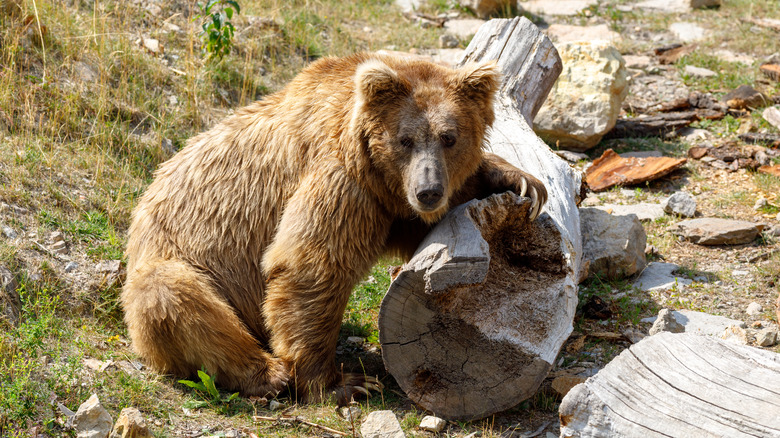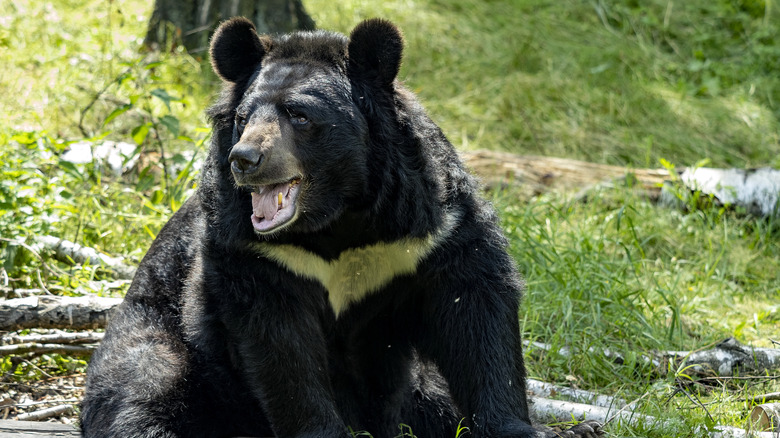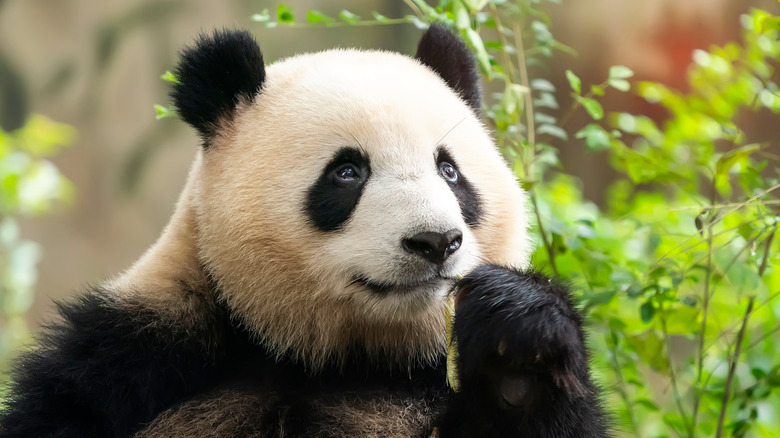11 Types Of Bears, Ranked By Danger Level
There are very few animals that have received the cute and cuddly treatment by Hollywood and literature more than bears. Think of Paddington, Winnie the Pooh, Fozzie, Baloo, and The Berenstain Bears. How adorable do all of these bears look? While Pooh might be a little suspect because he keeps a shotgun under his bed, the media has done a great disservice to these creatures. Why? Because bears are far more dangerous in reality than anything you'll find in a kids book or movie.
When they attack, bears are among the most dangerous mammals alive on this earth. Thanks to their size, weight, teeth, claws, and immense power, they are not the sort of animals that should be trifled with. However, some are certainly more dangerous than others. Don't get us wrong, all bears are dangerous to a degree. In fact, legally, the definition of a dangerous animal is one that poses an immediate threat to human life or property. Bears fit that bill.
Though several of the bears on this list will not attack unless provoked, their presence still poses a significant danger to anyone near them. Our bear danger level ranking is based on size, power, known aggressiveness, and how they go about the attack. So, without further ado, here are 11 types of bears, ranked by danger level.
1. Polar bear
There is a bit of a feud between the first two bears on this list because both are iconic for their aggression. However, biology wins the day in our ranking, giving the polar bear the top spot over the grizzly as the most dangerous bear. The largest bear in the world, polar bears clock in at an amazing size of 10 feet tall when standing, and commonly weigh over 1,700 pounds. These bears are what is known as an apex predator, meaning that they are at the top of the food chain and do not have any natural predators of their own.
Encounters with polar bears are relatively minimal thanks to the fact that they live in areas that are mostly uninhabited by people. However, should you invoke one's wrath, especially a female with cubs, you're not going to make it out the other side. Polar bears have incredibly sharp teeth, and a bite force of about 1,200 psi. They are designed for ripping blubber off of seals, so imagine what they will do to you? Polar bears are not fussy about eating humans, either. They have even been known to hunt humans in some cases.
So, if a polar bear wants you, there is not much you can do about it, short of shooting it. This is why if you plan on traveling to the Arctic, be sure to hire both a guide and a polar bear guard armed with a high-powered rifle.
2. Grizzly bear
The name "grizzly" is fitting of these behemoth beasts of the wild. They average 9 feet tall standing, and can weigh in excess of 1,500 pounds. Despite the weight, grizzly Bears can run up to 30 miles per hour in pursuit of prey. And humans are on that list, just after salmon and a little before moose. Just kidding, but not really.
Unlike their Arctic cousins, grizzly bears don't actively hunt down humans. Instead, they generally tend to avoid human contact. However, if a human enters their area, and provokes or makes the bear feel threatened, those 30 mph legs will kick in and that person is a goner. Though their size and weight make them incredibly formidable, the extended, powerful jaws of the grizzly are yet another reason why they are so dangerous. Remember, these bears stand in rivers and snatch jumping fish out of the air. And if you've ever fished for salmon before, you'll know they're no slouches in terms of their own strength.
Like their jaws, a grizzly bear's claws are extended, razor sharp, and can easily tear you apart as if you were a paper doll. Grizzlies are also very territorial and protective of their young. If they feel in any way threatened or intruded upon by you, they will attack. And when they do, you've got little chance of making it out alive.
3. Kamchatka brown bear
Also known as the Far Eastern brown bear, this subspecies of brown bear is native to the far eastern Russian peninsula of Kamchatka. These bears are actually hunted as trophies for wealthy clients. However, the fact that these bears are routinely hunted does not make their level of danger any less, because they are indeed formidable creatures.
Like many bears, the Kamchatka are omnivorous, preferring the likes of salmon, Arctic char, berries, and nuts to human flesh. However, their behavior is some of the most unpredictable you will encounter. They are extremely territorial and have been known to seemingly attack out of nowhere if someone trespasses. They are also extremely protective of their cubs. Female Kamchatka bears will raise cubs for 2 to 3 years before they go off on their own. So, if a hiker or hunter comes across a small cub, they'd do best to turn around and leave. Here's what could happen if they don't.
When standing, Kamchatka brown bears stand nearly 8 feet tall and weigh an average of 1,400 pounds. So, a body slam from one of these is enough to break several bones, and even kill. Yet, it is their incredibly powerful jaws and claws that have the potential to do the most damage. Razor sharp and enormous, they will turn a human body to mince in a matter of moments. Certainly doesn't sound like the way most of us would like to go.
4. Kodiak bear
Kodiak bears have not interacted with any other species of bear for over 12,000 years. This is because Kodiak's are the sole bear species that populates the Kodiak Archipelago in southwestern Alaska. Despite their solitary nature, however, Kodiak bears remain one of the most dangerous in the entire world. The Kodiak Islands have become something of a prime destination for tourists. Folks want to travel there to see the scenery, and to catch a glimpse of these elusive bears. It's this factor, most of all, that has contributed to the average of one serious injury caused by a Kodiak bear every year.
Another large apex predator, Kodiak bears reach an excess of 1,500 pounds and can stand nearly 10 feet tall. Their naturally secluded environment makes the Kodiak generally wary of people. However, this can make it seem as though someone can harmlessly get close enough to a bear to get a good picture, or even to touch one. This is a mistake.
While they aren't apt to tear you to shreds and kill you like polar and grizzly bears will, Kodiaks can give you a good swipe with their claws or a decent bite with their enormous teeth. It's their way of telling you to back off. The injuries that result are not like getting a scratch from your house cat. Kodiak wounds are big, and will require immediate medical attention. So, it's best to just admire these magnificent creatures from a distance.
5. Sun bear
Heading over to southeastern Asia, we find the sun bear. Though their name might suggest a sunny disposition, sun bears are anything but cuddly. They are the single most dangerous species of bear in southeastern Asia. They will attack without warning, sinking their incredibly long canine teeth into the arm, leg, or abdomen of an innocent passerby. Sun bears also sustain attacks, meaning that they will continue to maul until the prey question no longer poses a danger to them. In layman's terms: dead.
Still, you could be fooled into thinking that a sun bear is totally harmless. They are, after all, incredibly small, standing barely more than 5 feet on their hind legs and weighing often less than 150 pounds. However, to paraphrase Shakespeare, though they be but little, they are fierce. Do not, ever, confuse the sun bear's size and rather dopey demeanor for harmlessness. They are tough. They will attack. And when they do, they will not stop.
A growing problem for the sun bear is the increasing habitat destruction and encroachment into their natural territories. This is perhaps the main reason sun bear attacks are so common in southeastern Asia. Sun bears killed an astonishing 33 people in Mizoram, between 2000 and 2010, and more attacks are reported every year. So, rest assured, if you get on the wrong side of a sun bear, your likelihood of seeing the actual sun again is very low.
6. American black bear
The American black bear is the most common bear species in North America. Black bears are on the smaller side, standing not much more than 6 feet and weighing between 200 to 600 pounds. In bear terms, that's small. However, like the sun bear in Asia, American black bears make up for their size with sharp claws, large teeth, and immense strength. Though they may not look strong because of their tufty black fur, black bears are virtually all muscle, and will certainly attack if they feel overly threatened.
For black bears, there is safety in numbers. Unlike many of the bears on this list, black bears aren't completely solitary. Group formation occurs mostly in the form of mama black bears congregating with one another while raising their cubs. And even though they generally like to avoid people whenever possible, preferring to scamper up trees instead of charge, if you stray too close to their cubs, there is the chance mama will attack.
Black bear aggression does differ between north and south. Black bears that live in the northern reaches of North America are far more likely to be aggressive towards humans because they are not as well acclimated with us as their southern counterparts are. Plus, food is generally more scarce up north, which can lead black bears to take more daring measures to eat things they wouldn't normally. So, while you can survive a black bear attack, you certainly won't come away unscathed.
7. Sloth bear
Another bear with a misnomer of a name, Sloth bears are anything but lackadaisical. A rather rare ursine, sloth bears inhabit the wilds of rural India, Sri Lanka, and southern Nepal. They do feed mostly on plants, berries, and jungle insects as a means of securing protein. However, reported attacks have indicated that these bears are not to be trifled with. Here's why.
Though they are missing front teeth, the canines of a sloth bear are enormous, sharp, and can easily sink into human flesh with one powerful bite. Plus, their claws are sharp and long, making it easy for them to climb trees and tear their enemies to shreds. What's alarming is that, despite their relative rarity, sloth bears will attack anyone without warning or provocation. Like their fellow sun bear, the sloth bear is not incredibly large, weighing in at less than 500 pounds and standing barely more than 5 feet. However, it is their manifestation of aggression towards humans that makes them noteworthy.
Studies have indicated that it is due to their coexistence with tigers — another animal that has no qualms about hunting and killing humans — that has caused sloth bears to be so aggressive towards people. The attack and death numbers for this relatively rare bear are striking. Dozens of attacks and deaths occur each year, making these bears one of the most dangerous creatures on the planet.
8. Eurasian brown bear
Eurasian brown bears exist across much of Europe and the Asian continent. Like their cousins in Russia, the standard Eurasian brown bears stand around 8 feet tall and can easily weigh over 1,000 pounds. They have massive claws and teeth, and while they aren't naturally aggressive towards humans, there have been an increased number of brown bear related incidents in recent years that has created cause for concern.
Unlike polar bears, Eurasian browns don't usually display predatory behavior. In rural Romania, however, they supposedly do. Many attacks in the country have come as a result of the bears' attempt to steal and devour livestock, which is not considered normal brown bear behavior until just a few years ago. In fact, in 2019, three men died from bear attacks in the span of a month, and over 20 different instances were reported of livestock being apprehended and killed (via BBC).
There are postulated theories that the increase in attacks has to do with higher amounts of human contact, owing to population growth. However, brown bears are also naturally opportunistic, and will take a chance if they feel it is in their best interest. That is how they have become so widespread throughout the world. So, the presence of livestock and the deaths that have resulted from encounters may just be the result of adaptation to new situations. Unfortunately, these new situations have caused the bears to become all the more dangerous.
9. Himalayan brown bear
Do you believe in the Yeti? Whether you do or do not is actually irrelevant in this case, but we bring it up because of the fact that Himalayan brown bears are said to have given rise to the legend. Elusive to the point of people not believing they are not real, Himalayan brown bears do, in fact, exist. They also won't think twice about tearing hikers and weary travelers to shreds if they feel threatened.
With a habitat limited almost exclusively to the high mountains and valleys, Himalayan brown bears have increasingly been active in attacking villagers with food. This is likely owing to the food scarcity in the rural reaches of the Himalayas. Bear attacks have resulted in mangled faces, lost eyes, and can even kill people if the attack is sustained for long enough.
Though they are on the smaller side for a bear, (although they can weigh up to 800 pounds) and standing between 6 to 7 feet tall, their large claws and teeth will easily do the damage required in order for the bear to defend itself if it feels threatened. So, while you may not know you're entering bear territory, be forewarned that you could be set upon by one of these bears if you put your foot in the wrong place.
10. Asian black bear
Another ranking member of the black bear family, Asiatic black bears, also known as moon bears, are a distinctive and dangerous species of bear. They receive their name thanks to the large white patch that runs across their chest of night black fur. Unlike their American counterparts, who prefer to stay away from people, moon bears are incredibly aggressive towards humans. This is because where they live, China, Taiwan, Korea, and Japan, are among the most densely populated places in the world. Therefore, the likelihood of human contact is far greater, and Asian black bears are far less amenable to it than American black bears.
These little bears can become unbelievably savage when it comes to protecting themselves, and their young. If they feel as though they are in danger, or are provoked into attack, they will not stop until their foe is either mortally wounded or dead. Moon bears are also thought to be more carnivorous than the American black bear, which likely means that they won't have a problem devouring a foe after they've killed it.
Though they will not attack without warning like sloth or sun bears will, moon bears are nevertheless capable of killing a human without much convincing. Several cases of moon bear attacks have been recorded, and they frequently exhibit unpredictable behavior, which makes them all the more dangerous.
11. Giant panda bear
Finally, we come to the giant panda. There is perhaps no bear that has revived the Hollywood cuteness treatment more in recent decades than the panda. Though we all love to think of them as cuddly balls of black and white fur, pandas will attack you if you threaten them. While they don't know Kung Fu, and are more at home eating bamboo chutes than people, these giants of the Chinese wild can be absolutely vicious.
Seeing as bamboo is a tree, it's not the easiest thing in the world to eat raw. As a result, pandas have amazing jaw strength. So, when one lands its jaws on you, they will not let go until you're either dead or rescued. They are also known for their swipes with powerful paws. However, if you're unlucky enough to be in one's clutches, it's their teeth that they will likely attack with.
So there you have it. The most dangerous bears in the world, ranked. It goes without saying that you should always exhibit caution when entering any area that is known to be potentially populated by bears. There are ways of avoiding and surviving bear attacks, but the less you put yourself into situations where you could be attacked, the better. Because, as you have seen, these bears hold no quarter.
